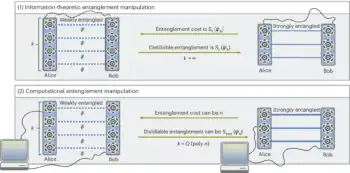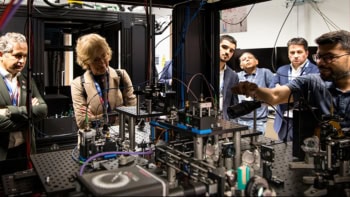
A group of physicists in the UK has made a programmable photonic circuit that can be used to carry out any kind of linear optics operation. The researchers say that the device provides experimental proof of a long-standing theory in quantum information, and could help speed the development of photonic quantum computers, as well as establishing whether quantum computers are fundamentally different from their classical counterparts.
The research builds on work carried out back in 1897 by German mathematician Adolf Hurwitz, who showed how a matrix of complex numbers known as a unitary operator can be built up from smaller 2 × 2 matrices. A unitary operator provides a mathematical description of a linear optical circuit. This is any circuit that uses fairly standard optical components – such as mirrors, half-silvered mirrors and phase shifters – to route photons and cause them to interfere with one other. The operator has as many rows as there are output ports in the circuit and as many columns as there are input ports. With only one photon in the circuit, the probability that it travels from a particular input to a particular output is given by the square of the corresponding matrix entry.
In 1994 Anton Zeilinger, then at the University of Innsbruck in Austria, and colleagues showed theoretically that since 2 × 2 matrices can describe the components used in linear optical circuits, such components can be configured to reproduce any unitary operator. More recently, Anthony Laing of the University of Bristol realized that by building a device capable of reproducing any unitary operator, it would be possible with that single device to carry out any linear optics experiment on the same number of input and output ports. Now, Laing and a number of Bristol colleagues have built and operated such a device.
Unitary operator on a chip
Laing designed the device so that it could sit on a single chip, explaining that problems of instability would make it close to impossible to build it using components on a lab bench. This is because any movement of a micron or more would prevent photons from combining coherently inside the circuit’s interferometers. Laing’s colleague Jacques Carolan points out that such “integrated optics” still poses challenges, such as how to fine-tune the waveguide couplers that act as tiny beam splitters, so that exactly half of the light from one of a pair of waveguides tunnels into the other. The researchers were able to overcome this particular problem by collaborating with scientists and engineers at the NTT Corporation in Japan.
The result is a silica-on-silicon device designed to fit onto a 6 inch wafer, comprising 15 interferometers and 30 electrically controlled phase shifters. The input is from six single-photon channels and the chip sends its output to an array of 12 single-photon counters. Christened a universal linear optical processor, or LPU (in analogy with a CPU), the device has been used by the Bristol researchers not only to prove the theory put forward by Zeilinger’s group, but also to demonstrate a number of specific applications.
One of these is the creation of a controlled NOT gate, a crucial component in certain types of quantum computer. Such a gate takes two quantum bits, or qubits, as input, and flips the state of one of the qubits only if the other qubit has a value of one. Physicists had thought that this nonlinearity could not be carried out using purely linear optics. But the Bristol group has used its LPU to demonstrate the validity of a theory put forward by Raymond Laflamme, then at Los Alamos National Laboratory, and colleagues in 2001, which predicted that certain kinds of additional measurement could induce nonlinearities even in purely linear optics.
Boson sampling machine
Among the other measurements they have carried out, Laing and co-workers have also operated the LPU as a “boson-sampling” machine, a kind of simplified quantum computer that carries out one, fixed task: working out the probability that photons arriving at a certain combination of input ports generate a particular output. Since boson samplers should be relatively easy to scale up, says Laing, they might allow quantum physicists to put the Church–Turing thesis to the test in the fairly near future. The thesis states that every kind of computation can be carried out on a Turing machine, which is essentially a classical digital computer. However Laing points out that quantum computation appears to violate that idea.
According to Laing, the LPU is completely reprogrammable and can be switched from one experiment to another in milliseconds. He says it could save experimentalists months building a particular linear optics experiment, operating it, and then dismantling it. He even suggests that it might prove to be an asset to theorists. “You don’t need to get your hands dirty using this,” he says. Carolan adds: “It’s exciting to think of all of the things the chip can do that we don’t yet even know about.”
‘Super-cool’, but limited
Paul Kwiat of the University of Illinois at Urbana-Champaign describes the latest work as “a tour de force of integrated optics engineering”. He points out, however, that the Bristol group doesn’t specify the fraction of photons that are lost in the LPU, and that the scheme still relies on external, nonlinear devices to supply and detect the photons. “It’s kind of like demonstrating a super-cool electric car but being limited by batteries that only allow you to drive 10 miles,” he says. “Once someone solves the battery problem, then the car will do amazing things.”
Laing acknowledges that the generation and detection of photons away from the chip introduces losses. The answer to this is to integrate all components, both linear and nonlinear, onto the same chip. “That is challenging,” he says. “But it is the direction that the field is moving in.”
The research is described in Science.



